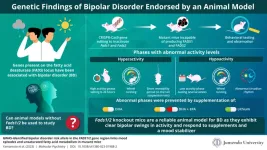(Press-News.org) “As a Black woman, I’m invisible. They just erase your humanity. You don’t exist in front of them.” (Tessa, 33-year-old Black research assistant)
“It wasn’t about disliking what I did or being judgmental of what I did. It was a different kind of problem, to not be acknowledged. They didn’t care. There was no curiosity. They didn’t give a f***. We were invisible.” (Brinda, 30-year-old South Asian consultant)
Invisibility is a salient and recurring experience of mistreatment for women of colour working in traditionally white and male professions, two researchers found in their recent landmark study. Barnini Bhattacharyya of the Ivey Business School at Western University and Jennifer Berdahl of University of British Columbia looked at a diverse sample of 65 women of colour in Canada and the U.S. for the study. Their paper, Do you see me? An Inductive Examination of Differences Between Women of Colour’s Experiences of and Responses to Invisibility at Work, was recently published in the Journal of Applied Psychology.
The study examines how differences in race, immigration status, age, and organizational status – which determined the women’s proximity to social power – informed the types of invisibility they experienced, as well as their responses to invisibility. Although there is much research examining workplace mistreatment experiences of women in general, very little research explores how women of colour experience and respond to workplace mistreatment.
“The study offers a more theoretically complete understanding of the experiences of invisibility for a variety of women of colour at work,” said Bhattacharyya. “By interviewing a diverse sample of women of colour, we identified distinct forms of invisibility that made them feel unseen for their true selves”
Powerful and revealing interviews show the experience of invisibility was common, painful, and dehumanizing for women of colour, and identified four distinct forms of invisibility:
Erasure, invisibility in its most literal sense, means being unheard or unseen. Ninety-five per cent of interviewees reported experiencing erasure at work. East/Southeast Asian women experienced erasure the most acutely frequently;
Homogenization is being treated like a homogenous and interchangeable member of an unrelatable out group. Eighty-six per cent of interviewees reported homogenization, often describing being treated as virtually indistinguishable from other women of colour. Even though Black women made up less than one-fifth of the sample, they represented one-third of those who experienced homogenization most acutely and frequently;
Exoticization is a unique race and gender-based sexualization that made women of colour feel reduced to foreign objects of fascination and fetishization. Seventy-eight per cent of interviewees experienced exoticization. Although most participants across racial groups reported exoticization, a disproportionate number of those women were younger and of lower organizational status. Further, every Latina woman and all but one Black woman noted being exoticized; and,
Whitening is when one’s similarities to white people are highlighted and complimented and non-white racial/ethnic identities and cultural backgrounds discounted and ignored. Fifty-one per cent of interviewees reported whitening, which was confusing because it was framed as inclusion and praise, but undermined the women’s racial and cultural identities, making them feel invisible. Most of the interviewees who reported whitening had grown up in Canada or the U.S., were older, and/or had high organizational status.
Importantly, the study identified three distinct responses to experiencing invisibility in the workplace. How women of colour attributed causes of their invisibility, combined with their social power, shaped whether they engaged in withdrawal, approach, or pragmatic responses.
In general, women of colour with less social power at work experienced invisibility most strongly. They were more likely to blame themselves for their invisibility, and were more likely to engage in withdrawal (e.g., further staying quiet, making themselves small), which intensified their invisibility and marginalization. Women with more social power experienced less invisibility. They were more likely to blame the perpetrator for their invisibility, and were more likely to engage in approach tactics (e.g. speaking up strongly against an invisibility experience, challenging the perpetrator), which risked backlash. Women who attributed their invisibility to structural causes (e.g. systemic racism, systemic sexism) were more likely to engage in pragmatic tactics. Although least common among the interviews, such tactics often empowered women to engage in radical honesty with those who had made them feel invisible.
“Our findings offer novel insights for organizational practices around diversity and inclusion by highlighting the complexity that exists within women of colour’s experiences at work,” said Bhattacharyya. “Some are more invisible than others, and women of colour experience, and respond to, invisibility in different ways depending on their identities and positions. This also gives women of colour legitimacy and language about subtle workplace mistreatment experiences.”
While the paper’s findings provide insight into the unique marginalization of women of colour in the workplace, they also highlight the need to design more sophisticated practices around Equity, Diversity, and Inclusion (EDI) at work. In particular, there is a need to pay attention to different ways in which marginalized groups experience mistreatment at work, and design EDI policies and tools that address them accordingly. Typically, there is a blanket EDI approach and solution (e.g. gender bystander intervention training) that only serves a few. Organizations also need to create climates and conditions for dialogue, where radically honest conversations can occur in psychologically and socially safe environments that recognize structural barriers to women of colour’s visibility and inclusion in organizations.
The full text of the paper is available on the website of the Journal of Applied Psychology: https://psycnet.apa.org/fulltext/2023-45629-001.html
Authors:
Barnini Bhattacharyya, Assistant Professor, Organizational Behaviour, Ivey Business School at Western University
Jennifer L. Berdahl, Professor, Department of Sociology, University of British Columbia
END
Do you see me? New study examines how women of colour experience invisibility in the workplace
2023-03-07
ELSE PRESS RELEASES FROM THIS DATE:
Muffins that could be good for your health
2023-03-07
Love muffins? We’re talking about a tasty, fluffy muffin that has no artificial additives and that simultaneously contains lots of beneficial nutrients. As remarkable as it might sound, a recently published study led describes the development of just such a new muffin in the journal Foods.
From muffins to functional food
The new super muffin has been named Roselle, because it contains calyx extract from the tropical plant Hibiscus sabdariffa, which is often referred to by the same name.
[caption id="attachment_79738" align="aligncenter" width="559"] Here's a look at the different formulations that researchers tested. Photo: Screenshot from Food ...
Join us at #DiscoverBMB 2023 for the latest molecular life sciences research
2023-03-07
Will AI drive the next biomedical revolution? Why is RNA so powerful? What can we learn from studying bias? You’ll get the answers to these questions and more at Discover BMB, the annual meeting of the American Society for Biochemistry and Molecular Biology, to be held March 25–28 in Seattle.
Reporters are invited to register for a complimentary press pass to attend #DiscoverBMB in Seattle or to access press materials electronically.
This year’s #DiscoverBMB program features leading ...
The colors on these ancient pots hint at the power of an empire
2023-03-07
Color plays a huge role in our lives — the hues we wear and decorate with are a way for us to signal who we are, where we’re from, and what we care about. And it’s been that way for a long time. In a new study in the Journal of Archaeological Science: Reports, archaeologists compared the colors on pieces of ancient Peruvian pottery. They found that potters across the Wari empire all used the same rich black pigment to make ceramics used in rituals: a sign of the empire’s influence.
The Wari empire spread over Peru’s highlands and coastal areas from 600-1050 ...
Does current shellfish anti-predator gear curb ‘crunching’ rays?
2023-03-07
According to NOAA Fisheries, more than 80 percent of marine aquaculture production in the United States consists of bivalve mollusks such as oysters, clams and mussels. However, it’s not just humans who enjoy eating these shellfish, so do marine rays. They like to “crunch” on clams, which can sometimes take a big bite out of clammers’ profits.
Part of the process of culturing hard clams (Mercenaria mercenaria) involves deploying them in submerged bottom leases in the marine environment where clams can grow to market size. When deployed onto the clam lease, clammers incorporate a variety of anti-predator ...
Understanding what makes senior towns in Iowa “smart”
2023-03-07
AMES, IA — With the youngest baby boomers sliding into retirement, adults aged 65 and older are expected to outnumber children by 2030. The demographic shift will be a first in U.S. history. But many rural areas, especially in the Midwest and Great Plains, are already experiencing this.
Researchers are looking to small towns in Iowa to understand how some support aging in place better than others. Their findings, published in Journal of Rural Studies, could help communities plan for the ...
Researchers create mutant mice to study bipolar disorder
2023-03-07
Bipolar disorder (BD) is a debilitating condition characterized by alternating states of depression (known as depressive episodes) and abnormal excitement or irritability (known as manic episodes). Large-scale genome-wide association studies (GWASs) have revealed that variations in the genes present on the fatty acid desaturase (FADS) locus are linked to an increased risk of BD. Enzymes coded by FADS genes—FADS1 and FADS2—convert or "biosynthesize" omega-3 fatty acids into the different forms required by the human body. Omega-3 fatty acids like ...
New breakthrough enables perfectly secure digital communications
2023-03-07
Researchers have achieved a breakthrough to enable ‘perfectly secure’ hidden communications for the first time.
The method uses new advances in information theory methods to conceal one piece of content inside another in a way that cannot be detected.
This may have strong implications for information security, besides further applications in data compression and storage.
A group of researchers has achieved a breakthrough in secure communications by developing an algorithm that conceals sensitive information so effectively that it is impossible to detect that anything has been hidden.
The team, led by ...
CNIO researchers propose biomarkers to select breast cancer patients who could benefit from denosumab treatment
2023-03-07
The study supports the therapeutic benefit of this drug in postmenopausal patients with hormone-receptor negative breast tumours and RANK protein expression.
"These results revive the option of starting clinical trials of denosumab in breast cancer by selecting patients," says Eva González-Suarez, CNIO researcher and lead author.
The results are published today in the scientific journal EMBO Molecular Medicine.
The drug denosumab is currently used to treat osteoporosis and bone metastases. For more than a decade, its potential therapeutic benefit in the treatment of breast cancer has also been studied. However, due to conflicting clinical ...
The planet that could end life on Earth
2023-03-07
A terrestrial planet hovering between Mars and Jupiter would be able to push Earth out of the solar system and wipe out life on this planet, according to a UC Riverside experiment.
UCR astrophysicist Stephen Kane explained that his experiment was meant to address two notable gaps in planetary science.
The first is the gap in our solar system between the size of terrestrial and giant gas planets. The largest terrestrial planet is Earth, and the smallest gas giant is Neptune, which is four times wider and 17 times more massive than Earth. There is nothing in between.
“In other star ...
Scientists suggest guidelines to prevent SARS-CoV-2 transmission from deceased individuals
2023-03-07
Their findings highlight that embalming or "angel care" can effectively prevent virus transmission, to allow family members to say goodbye
During the pandemic, COVID-19 control measures in several countries prevented family members from coming into contact with loved ones who died from the infection. This had an impact on cremation practices and caused emotional distress. Researchers from Japan have now shown that, while deceased SARS-CoV-2-infected individuals may be a potential source of the ...







